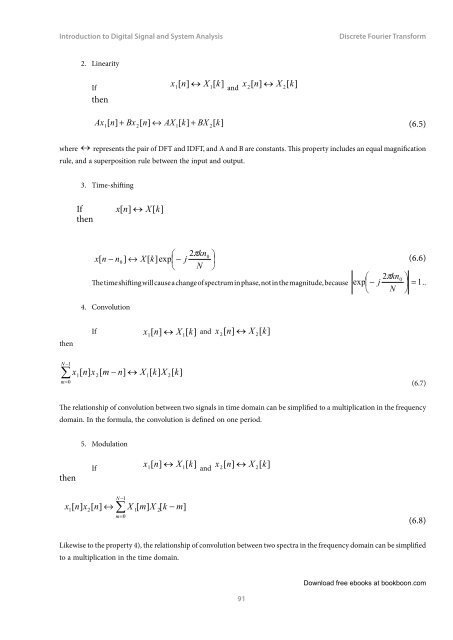Introduction to Digital Signal and System Analysis - Tutorsindia
Introduction to Digital Signal and System Analysis - Tutorsindia
Introduction to Digital Signal and System Analysis - Tutorsindia
You also want an ePaper? Increase the reach of your titles
YUMPU automatically turns print PDFs into web optimized ePapers that Google loves.
<strong>Introduction</strong> <strong>to</strong> <strong>Digital</strong> <strong>Signal</strong> <strong>and</strong> <strong>System</strong> <strong>Analysis</strong><br />
Discrete Fourier Transform<br />
2. Linearity<br />
If<br />
then<br />
x1[ n]<br />
↔ X<br />
1[<br />
k]<br />
<strong>and</strong><br />
x<br />
2[ n]<br />
↔ X<br />
2[<br />
k]<br />
Ax n]<br />
+ Bx [ n]<br />
↔ AX [ k]<br />
+ BX [ ] (6.5)<br />
1[ 2<br />
1<br />
2<br />
k<br />
where ↔ represents the pair of DFT <strong>and</strong> IDFT, <strong>and</strong> A <strong>and</strong> B are constants. This property includes an equal magnification<br />
rule, <strong>and</strong> a superposition rule between the input <strong>and</strong> output.<br />
3. Time-shifting<br />
If x[ n]<br />
↔ X [ k]<br />
then<br />
2πkn<br />
<br />
− ↔ −<br />
0<br />
x[<br />
n n0<br />
] X [ k]exp<br />
j (6.6)<br />
N <br />
2πkn<br />
0 <br />
The time shifting will cause a change of spectrum in phase, not in the magnitude, because exp<br />
− j = 1. .<br />
N <br />
4. Convolution<br />
then<br />
If x n]<br />
↔ X [ ] <strong>and</strong> x n]<br />
↔ X [ ]<br />
1[ 1<br />
k<br />
2[ 2<br />
k<br />
N<br />
1<br />
∑ − x1[ n]<br />
x<br />
2[<br />
m − n]<br />
↔ X<br />
1[<br />
k]<br />
X<br />
2[<br />
k]<br />
m= 0<br />
(6.7)<br />
The relationship of convolution between two signals in time domain can be simplified <strong>to</strong> a multiplication in the frequency<br />
domain. In the formula, the convolution is defined on one period.<br />
5. Modulation<br />
then<br />
If<br />
x1[ n]<br />
↔ X<br />
1[<br />
k]<br />
<strong>and</strong><br />
x<br />
2[ n]<br />
↔ X<br />
2[<br />
k]<br />
x<br />
N<br />
− 1<br />
1<br />
[ n]<br />
x2[<br />
n]<br />
↔ X<br />
1[<br />
m]<br />
X<br />
2[<br />
k − m]<br />
m=<br />
0<br />
(6.8)<br />
Likewise <strong>to</strong> the property 4), the relationship of convolution between two spectra in the frequency domain can be simplified<br />
<strong>to</strong> a multiplication in the time domain.<br />
91<br />
Download free ebooks at bookboon.com
















